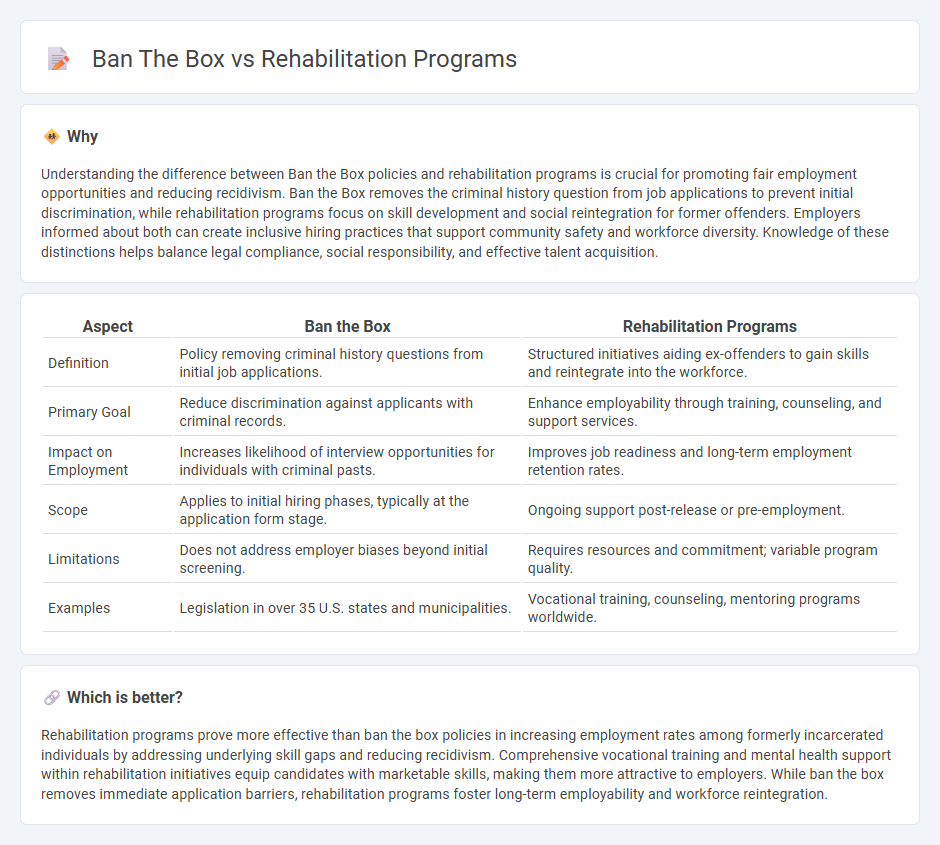
Ban the Box policies remove criminal history questions from initial job applications to reduce employment barriers for ex-offenders, increasing their chances of being considered based on qualifications. Rehabilitation programs focus on skill development and mental health support to improve reintegration outcomes and reduce recidivism rates. Explore how these approaches impact employment opportunities for individuals with criminal records.
Why it is important
Understanding the difference between Ban the Box policies and rehabilitation programs is crucial for promoting fair employment opportunities and reducing recidivism. Ban the Box removes the criminal history question from job applications to prevent initial discrimination, while rehabilitation programs focus on skill development and social reintegration for former offenders. Employers informed about both can create inclusive hiring practices that support community safety and workforce diversity. Knowledge of these distinctions helps balance legal compliance, social responsibility, and effective talent acquisition.
Comparison Table
| Aspect | Ban the Box | Rehabilitation Programs |
|---|---|---|
| Definition | Policy removing criminal history questions from initial job applications. | Structured initiatives aiding ex-offenders to gain skills and reintegrate into the workforce. |
| Primary Goal | Reduce discrimination against applicants with criminal records. | Enhance employability through training, counseling, and support services. |
| Impact on Employment | Increases likelihood of interview opportunities for individuals with criminal pasts. | Improves job readiness and long-term employment retention rates. |
| Scope | Applies to initial hiring phases, typically at the application form stage. | Ongoing support post-release or pre-employment. |
| Limitations | Does not address employer biases beyond initial screening. | Requires resources and commitment; variable program quality. |
| Examples | Legislation in over 35 U.S. states and municipalities. | Vocational training, counseling, mentoring programs worldwide. |
Which is better?
Rehabilitation programs prove more effective than ban the box policies in increasing employment rates among formerly incarcerated individuals by addressing underlying skill gaps and reducing recidivism. Comprehensive vocational training and mental health support within rehabilitation initiatives equip candidates with marketable skills, making them more attractive to employers. While ban the box removes immediate application barriers, rehabilitation programs foster long-term employability and workforce reintegration.
Connection
Ban the Box policies and rehabilitation programs work together to improve employment opportunities for formerly incarcerated individuals by removing initial barriers that disclose criminal history on job applications. These initiatives foster fair hiring practices and support reintegration by increasing access to jobs, reducing recidivism, and promoting economic stability. Employers benefit from a broader talent pool while society gains from decreased unemployment rates among rehabilitated workers.
Key Terms
Recidivism
Rehabilitation programs targeting recidivism emphasize skill-building, therapy, and education to reduce repeat offenses by addressing underlying causes of criminal behavior. Ban the Box policies improve employment opportunities for formerly incarcerated individuals by removing criminal history questions from job applications, which can indirectly reduce recidivism through increased economic stability. Explore more about how these strategies impact recidivism rates and support reentry success.
Unconscious Bias
Rehabilitation programs aim to reduce recidivism by providing support and skill-building for formerly incarcerated individuals, addressing systemic barriers to reintegration. "Ban the box" initiatives seek to eliminate early disclosure of criminal history on job applications to combat unconscious bias that unfairly penalizes candidates with a criminal record. Discover how both approaches influence hiring equity and dismantle hidden prejudices in the recruitment process.
Workplace Reintegration
Rehabilitation programs emphasize skill development, mental health support, and gradual workplace reintegration to reduce recidivism and promote sustainable employment for formerly incarcerated individuals. Ban the Box policies remove criminal history questions from initial job applications, aiming to reduce hiring bias and increase fair access to employment opportunities. Explore deeper insights on how these approaches transform workplace reintegration and support inclusive hiring practices.
Source and External Links
Types of Rehabilitation Programs in Prisons - This webpage explores various types of rehabilitation programs in prisons, including occupational and psychological rehabilitation, aimed at reducing recidivism and improving societal outcomes.
Rehabilitative Programs and Services - This webpage details comprehensive rehabilitative programs and services available in prisons and post-release, focusing on educational, treatment, and pre-release programs.
Types of Inmate Rehabilitation Programs - This webpage highlights nine types of inmate rehabilitation programs, ranging from initial assessments to educational and vocational training, designed to address diverse inmate needs.
 dowidth.com
dowidth.com